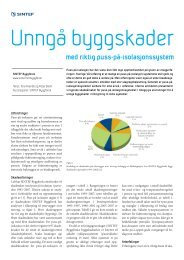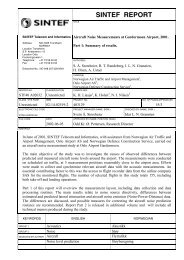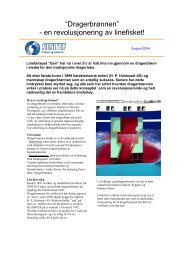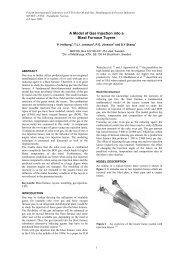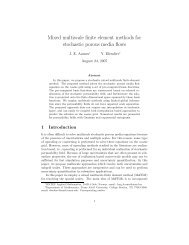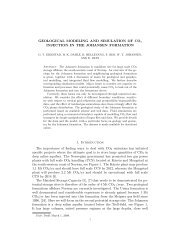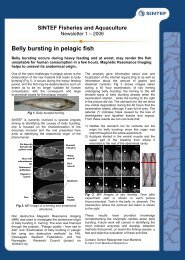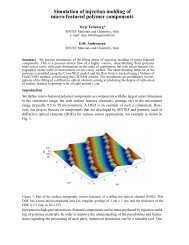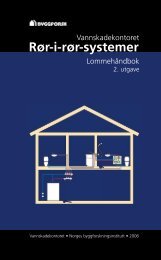Real-Time GPU Silhouette Refinement using adaptively blended ...
Real-Time GPU Silhouette Refinement using adaptively blended ...
Real-Time GPU Silhouette Refinement using adaptively blended ...
You also want an ePaper? Increase the reach of your titles
YUMPU automatically turns print PDFs into web optimized ePapers that Google loves.
implies that our algorithm must recompute the Bézier coefficientsaccordingly. Our implementation is describedsequentially, although some steps do not require the previousstep to finish. A flowchart of the implementationcan be found in Figure 7.6.1 <strong>Silhouette</strong>ness calculation<strong>Silhouette</strong>ness is well suited for computation on the <strong>GPU</strong>since it is the same transform applied to every edge andsince there are no data dependencies. The only changingparameter between frames is the viewpoint.If the mesh is static we can pre-compute the edgemidpointsand neighboring triangle normals for everyedge as a preprocessing step and store these values in atexture on the <strong>GPU</strong>. For a dynamic mesh we store the indicesof the vertices of the two adjacent triangles insteadand calculate the midpoint as part of the silhouettenesscomputation.The silhouetteness of the edges is calculated by firstsending the current viewpoint to the <strong>GPU</strong> as a shader uniform,and then by issuing the rendering of a textured rectangleinto an off-screen buffer with the same size as ouredge-midpoint texture.We could alternatively store the edges and normals ofseveral meshes in one texture and calculate the silhouettenessof all in one pass. If the models have different modelspace bases, such as in a scene graph, we reserve a texelin a viewpoint-texture for each model. In the preprocessingstep, we additionally create a texture associating theedges with the model’s viewpoint texel. During renderingwe traverse the scene graph, find the viewpoint in themodel space of the model and store this in the viewpointtexture. We then upload this texture instead of setting theviewpoint explicitly.6.2 Histogram pyramid construction andextractionThe next step is to determine which triangles should berefined, based on the silhouetteness of the edges. Thestraightforward approach is to read back the silhouettenesstexture to host memory and run sequentially throughthe triangles to determine the refinement level for each ofthem. This direct approach rapidly congests the graphicsbus and thus reduces performance. To minimize transfersover the bus we use a technique called histogram pyramidextraction [23] to find and compact only the data thatwe need to extract for triangle refinement. As an addedbenefit the process is performed in parallel on the <strong>GPU</strong>.The first step in the histogram pyramid extraction is toselect the elements that we will extract. We first create abinary base texture with one texel per triangle in the mesh.A texel is set to 1 if the corresponding triangle is selectedfor extraction, i.e. has at least one edge with non-zerosilhouetteness, and 0 otherwise. We create a similar basetexture for the edges, setting a texel to 1 if the correspondingedge has at least one adjacent triangle that is selectedand 0 otherwise.For each of these textures we build a histopyramid,which is a stack of textures similar to a mipmap pyramid.The texture at one level is a quarter of the size of theprevious level. Instead of storing the average of the fourcorresponding texels in the layer below like for a mipmap,we store the sum of these texels. Thus each texel in thehistopyramid contains the number of selected elements inthe sub-pyramid below and the single top element containsthe total number of elements selected for extraction.Moreover, the histopyramid induces an ordering of the selectedelements that can be obtained by traversal of thepyramid. If the base texture is of size 2 n ×2 n , the histopyramidis built bottom up in n passes. Note that for a staticmesh we only need a histopyramid for edge extraction andcan thus skip the triangle histopyramid.The next step is to compact the selected elements. Wecreate a 2D texture with at least m texels where m is thenumber of selected elements and each texel equals its indexin a 1D ordering. A shader program is then used tofind for each texel i the corresponding element in the basetexture as follows. If i > m there is no corresponding selectedelement and the texel is discarded. Otherwise, thepyramid is traversed top-down <strong>using</strong> partial sums at theintermediate levels to determine the position of the i’thselected element in the base texture. Its position in thebase texture is then recorded in a pixel buffer object.The result of the histopyramid extraction is a compactrepresentation of the texture positions of the elements forwhich we need to extract data. The final step is to load associateddata into pixel buffer objects and read them backto host memory over the graphics bus. For static mesheswe output for each selected edge its index and silhouetteness.We can thus fit the data of two edges in the RGBADraftDraft7




